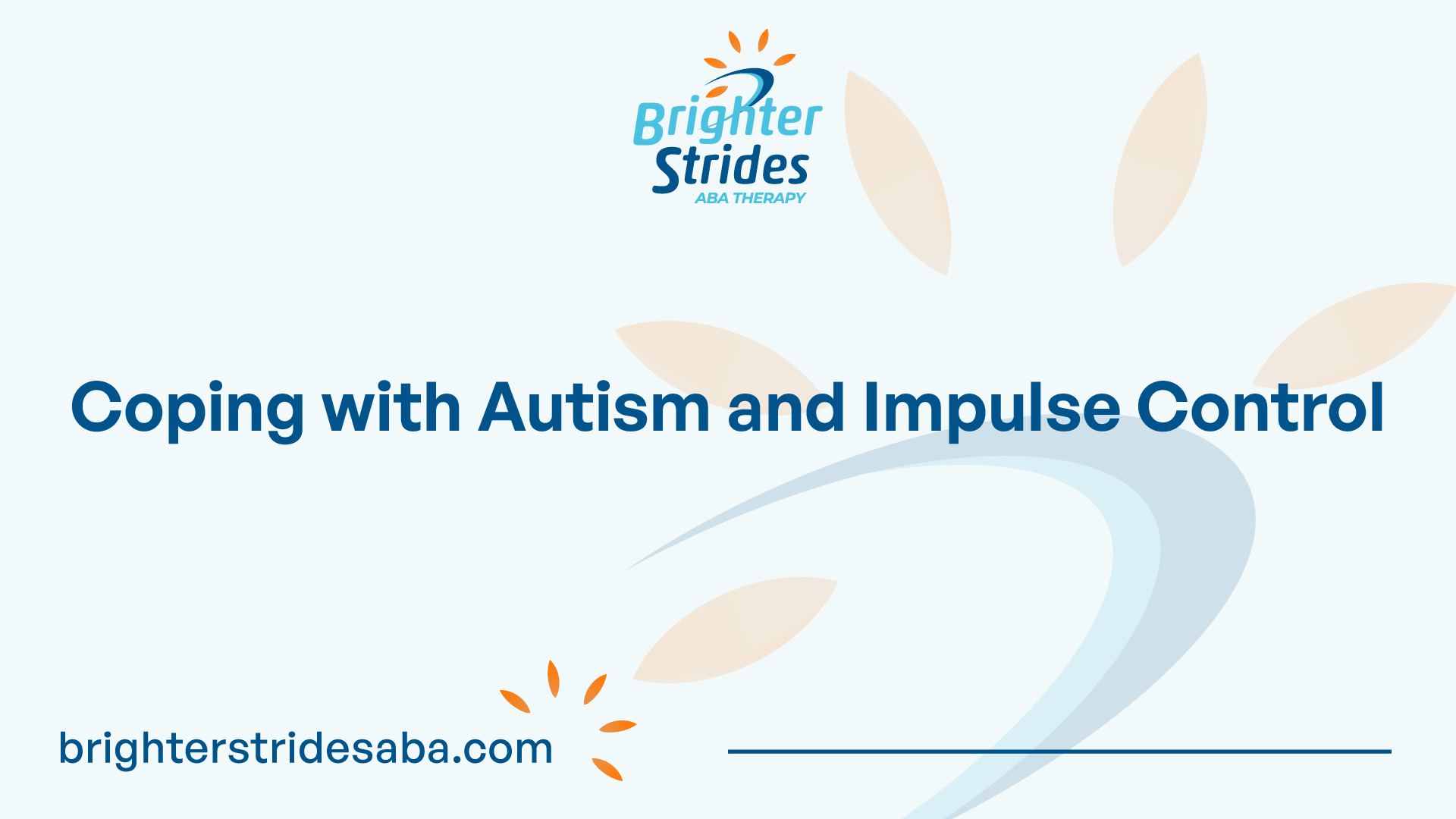Understanding Impulse Control in Autism
Impulse control challenges are common in individuals with autism and can significantly impact their daily lives. Impulse control refers to the ability to resist temptation and regulate one’s behavior in a given situation. For individuals with autism, impulse control difficulties can manifest in various ways, including impulsive behaviors, acting without thinking, interrupting others, or engaging in repetitive or self-stimulatory behaviors.

Impulse Control Challenges
Impulsivity is considered a core feature of autism, and individuals with autism often struggle with impulse control. Some of the challenges they may experience include:
- Difficulty waiting their turn: Individuals with autism may find it challenging to wait patiently in various situations, such as during conversations, games, or activities.
- Interrupting others: Impulse control difficulties can lead to a tendency to interrupt or talk over others, potentially impacting social interactions and communication.
- Blurting out inappropriate comments: Some individuals with autism may have difficulties filtering their thoughts before verbalizing them, leading to blurting out comments that may be considered socially inappropriate.
- Engaging in repetitive behaviors: Repetitive behaviors, such as hand flapping or rocking, can serve as a way for individuals with autism to regulate sensory input or manage internal anxiety.
Contributing Factors
Several factors contribute to impulse control challenges in individuals with autism. These include:
- Cognitive and sensory processing differences: Individuals with autism may have unique cognitive and sensory processing profiles that contribute to impulse control difficulties. Challenges in understanding and interpreting social cues, recognizing and regulating emotions, and maintaining attention can impact their ability to control impulsive behaviors.
- Executive functioning deficits: Executive functioning refers to a set of cognitive processes responsible for self-regulation, planning, decision-making, and impulse control. Many individuals with autism experience deficits in these executive functions, making it more challenging to regulate their impulses.
Understanding the underlying challenges and contributing factors to impulse control difficulties in autism is crucial for developing effective strategies and interventions to support individuals with autism in managing their impulses and fostering positive behavioral outcomes.
Therapeutic Approaches for Impulse Control
When it comes to addressing impulse control challenges in individuals with autism, therapeutic approaches play a crucial role in promoting self-regulation and enhancing daily functioning. Two effective therapeutic approaches for improving impulse control in individuals with autism are Occupational Therapy (OT) and the implementation of various strategies and techniques.
Occupational Therapy (OT)
Occupational therapy (OT) can be a valuable therapeutic approach for individuals with autism who struggle with impulse control. OT focuses on enhancing the individual’s ability to engage in meaningful and purposeful activities, improving their overall quality of life. Through a comprehensive assessment, occupational therapists identify specific areas of challenge related to impulse control and develop personalized interventions to address these difficulties.
Occupational therapists work closely with individuals with autism and their families to develop strategies and interventions that promote self-control and reduce impulsive behaviors. These interventions may include:
- Providing a structured and predictable environment: Creating a predictable routine and using visual supports, such as schedules and timers, can help individuals with autism anticipate and prepare for transitions, reducing impulsive reactions.
- Sensory regulation techniques: Implementing sensory breaks throughout the day and teaching sensory regulation techniques, such as deep breathing exercises and sensory integration activities, can help individuals with autism regulate their sensory experiences and manage impulsive behaviors.
- Social stories and visual supports: Using social stories and visual supports can assist individuals with autism in understanding appropriate behaviors, making choices, and predicting the consequences of impulsive actions. These visual tools provide guidance and support for self-control.
- Mindfulness practices: Incorporating mindfulness activities, such as meditation, deep breathing, body scanning, and yoga, can help individuals with autism develop self-awareness, emotional regulation, and impulse control.
Strategies and Techniques
In addition to occupational therapy, various strategies and techniques can be implemented to support individuals with autism in improving their impulse control. These strategies aim to create a structured and predictable environment while providing tools and resources for self-regulation. Some effective strategies for enhancing impulse control in individuals with autism include:
- Structured and predictable environment: Establishing a structured routine and providing clear expectations can help individuals with autism anticipate and manage their impulses. Consistency and predictability create a sense of security and promote self-control.
- Sensory regulation techniques: Incorporating sensory breaks throughout the day allows individuals with autism to self-regulate and manage sensory overload. These breaks can include engaging in calming activities, such as deep pressure exercises or using sensory tools, to reduce impulsive behaviors.
- Social stories and role-playing: Using social stories and role-playing scenarios can help individuals with autism understand appropriate behaviors in different social situations and practice self-control.
- Visual supports and timers: Visual supports, such as visual schedules, visual cues, and timers, can aid individuals with autism in understanding and following routines, managing time, and staying focused, reducing impulsive reactions.
- Cognitive strategies: Cognitive approaches, such as cognitive behavioral therapy (CBT), mindfulness practices, self-reflection, and journaling, can help individuals with autism develop self-mastery and enhance impulse control.
By combining therapeutic approaches like occupational therapy with the implementation of strategies and techniques, individuals with autism can develop effective impulse control skills and enhance their overall self-regulation abilities. It’s important to work closely with professionals and caregivers to tailor interventions to the specific needs and preferences of each individual.
Impact of Impulse Control on Daily Life
Individuals with autism often experience challenges with impulse control, which can have a significant impact on various aspects of their daily lives. Understanding these impacts is crucial for developing effective strategies to support them in navigating social relationships, as well as achieving success in school and work.
Social Relationships
Impulse control problems in individuals with autism can manifest in various ways, such as tantrum behaviors, aggression, extreme reactions to minor issues, interrupting others during conversation, and difficulty taking turns. These impulsive behaviors can significantly impact social functioning and lead to emotional distress and embarrassment for individuals on the autism spectrum.
Difficulties with impulse control can hinder the development of meaningful relationships and social interactions. The challenges in regulating impulsive behavior may result in misunderstandings, social rejection, and isolation. It is important to address these issues to enhance self-esteem, promote positive social experiences, and improve the overall well-being of individuals with autism.
School and Work Success
Impulse control plays a vital role in academic and professional settings. Difficulties with impulse control, such as challenges with focus, being easily distracted, and problems following directions, can significantly impact a student’s ability to learn and succeed in the classroom. Additionally, impulsive behaviors can disrupt the learning environment for both the individual and their peers.
Similarly, in the workplace, impulse control challenges can hinder productivity and job performance. Difficulties with maintaining focus, controlling impulsive reactions, and following instructions can impede an individual’s ability to complete tasks efficiently and collaborate effectively with colleagues.
To address these challenges, it is important to provide individuals with autism appropriate support and strategies to develop impulse control skills. By providing structured environments, sensory regulation techniques, and other evidence-based strategies, individuals with autism can enhance their ability to manage impulses, improve their social interactions, and achieve success in academic and professional settings.
With the right interventions and support, individuals with autism can develop the necessary skills to manage impulse control challenges, leading to improved social relationships, enhanced educational experiences, better job performance, and an overall improved quality of life.
Practical Strategies for Improving Impulse Control
When it comes to individuals with autism, improving impulse control is crucial for their overall well-being and daily functioning. Fortunately, there are practical strategies that can be implemented to support individuals in managing their impulses effectively. Two key strategies include creating a structured environment and utilizing sensory regulation techniques.
Structured Environment
Providing a structured and predictable environment is essential for individuals with autism to develop impulse control strategies. A structured environment helps establish routines, promotes predictability, and reduces anxiety, which can contribute to impulsive behaviors. By implementing the following strategies, individuals with autism can better navigate their surroundings and enhance their impulse control:
- Establishing clear rules and expectations: Clearly defining rules and expectations helps individuals understand appropriate behavior and provides a framework for self-control.
- Visual supports and timers: Visual supports, such as visual schedules and timers, help individuals anticipate and transition between activities. They provide a visual representation of time and aid in managing impulses by promoting a sense of structure and predictability.
- Social stories and role-playing: Social stories and role-playing can be effective tools for teaching individuals with autism about appropriate social behaviors and the consequences of impulsive actions. These techniques help individuals develop a better understanding of expected behaviors in various situations.
Sensory Regulation Techniques
Sensory regulation techniques play a vital role in improving impulse control for individuals with autism. Sensory issues can contribute to heightened anxiety and difficulty managing impulses. By incorporating the following techniques, individuals with autism can better regulate their sensory experiences, leading to improved impulse control:
- Sensory breaks throughout the day: Providing regular sensory breaks allows individuals to engage in activities that help regulate their sensory systems. These breaks can include activities such as deep pressure exercises, stretching, or using sensory tools like fidget toys.
- Sensory integration techniques: Sensory integration techniques involve engaging in activities that target specific sensory needs. This can include activities like swinging, bouncing on a therapy ball, or engaging in proprioceptive activities like heavy work exercises.
- Mindfulness practices: Mindfulness practices, such as deep breathing, body scanning, meditation, and yoga, can help individuals with autism develop self-awareness and manage impulsive urges. These practices promote a sense of calmness and help individuals redirect their attention away from impulsive thoughts and behaviors.
Implementing these practical strategies can significantly support individuals with autism in improving their impulse control skills. It’s important to remember that every individual is unique, and what works for one person may not work for another. Tailoring strategies to meet the specific needs and preferences of individuals with autism is key to promoting successful impulse control.
Executive Functioning and Impulse Control
Impulse control challenges are often associated with executive dysfunction in individuals with autism. Executive dysfunction refers to cognitive, behavioral, and emotional difficulties that can arise due to neurodevelopmental disorders or traumatic frontal lobe injury. It encompasses challenges such as difficulty with planning, organizing, problem-solving, and time management.
Executive Dysfunction in Autism
Children with autism may experience stress and struggle with executive functioning challenges, making daily tasks difficult. Executive dysfunction can manifest in various ways, including impulsivity and difficulties with self-regulation. These challenges can impact an individual’s ability to control impulsive behaviors and make thoughtful decisions.
It is important to recognize and understand the executive functioning difficulties that individuals with autism may face. By doing so, we can provide appropriate support and interventions to help improve their executive function skills.
Developing Executive Function Skills
Despite the challenges associated with executive dysfunction, individuals with autism can develop skills to improve their executive functioning. Various activities and resources tailored to their interests and strengths can enhance skills such as working memory, task initiation, impulse control, adaptability, planning and organizing, and self-awareness.
Structured environments and schedules can provide a framework that supports executive function development. Breaking down larger tasks into smaller, manageable steps can help individuals with autism navigate daily activities more effectively. Visual supports, such as visual schedules and checklists, can also aid in promoting organization and planning skills.
Additionally, sensory regulation techniques, such as deep breathing exercises or sensory breaks, can help individuals with autism regulate their emotions and impulses. These techniques provide a means for sensory input and self-calming, allowing individuals to better manage impulsive behaviors.
By recognizing the executive functioning challenges that individuals with autism may face and providing them with appropriate support and interventions, we can help them develop and strengthen their executive function skills. This, in turn, can contribute to improved impulse control and overall quality of life.
Treatment Options and Interventions
When it comes to addressing impulse control challenges in individuals with autism, there are various treatment options and interventions available. Two effective approaches that have shown positive outcomes are Cognitive Behavioral Therapy (CBT) and mindfulness practices.
Cognitive Behavioral Therapy (CBT)
Cognitive Behavioral Therapy (CBT) is a widely used therapeutic approach for individuals with autism to improve impulse control. CBT focuses on identifying and modifying negative thought patterns and behaviors through structured sessions with a trained therapist. This approach helps individuals develop coping strategies and problem-solving skills, enabling them to better manage impulsive behaviors.
In the context of autism and impulse control, CBT can assist individuals in recognizing triggers that lead to impulsive actions and teach them alternative, more adaptive responses. By challenging and reframing negative thoughts and beliefs, individuals can gain better control over their impulses and make more informed choices.
Research has shown that CBT can be effective in reducing impulsive behaviors and improving self-regulation skills in individuals with autism [2]. It is important to note that CBT should be tailored to each individual’s specific needs and implemented by trained professionals in the field.
Mindfulness Practices
Mindfulness practices, such as meditation and self-reflection, have also been found to be beneficial for individuals with autism in enhancing impulse control. Mindfulness involves being fully present in the moment, non-judgmentally observing one’s thoughts and feelings, and cultivating a sense of awareness.
Through mindfulness practices, individuals with autism can learn to recognize their impulsive urges without immediately acting on them. By developing a greater sense of self-awareness and the ability to observe their thoughts and emotions, individuals can gain better control over impulsive behaviors.
Mindfulness practices can be integrated into daily routines and activities, allowing individuals to build resilience and self-regulation skills over time. It is important to note that mindfulness practices may need to be adapted to suit the unique needs and preferences of individuals with autism.
Both Cognitive Behavioral Therapy (CBT) and mindfulness practices offer valuable tools and strategies for individuals with autism to improve impulse control and enhance self-regulation skills. These interventions, when implemented with the guidance of trained professionals, can have a positive impact on the daily lives of individuals with autism.
References
- https://www.adinaaba.com/post/autism-and-impulse-control
- https://www.crossrivertherapy.com/autism/autism-and-impulse-control
- https://www.abtaba.com/blog/autism-and-impulse-control
- https://carmenbpingree.com/blog/the-relationship-between-autism-and-impulse-control/
- https://www.autismparentingmagazine.com/autism-impulse-control-disorder/

 We've just released an article!
Check out our blog!
We've just released an article!
Check out our blog!



